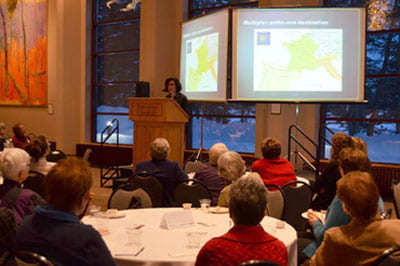Photo gallery: Ortiz, ‘After Thoughts,’ sacred path
 An ancient pilgrimage experiencing resurgent popularity was the focus of the third After Thoughts program of the academic year March 4, as Associate Prof. Cristina Ortiz brought the route and its traditions to life.
An ancient pilgrimage experiencing resurgent popularity was the focus of the third After Thoughts program of the academic year March 4, as Associate Prof. Cristina Ortiz brought the route and its traditions to life.
Ortiz, Humanistic Studies (Spanish) spoke before a full house in the Grand Foyer of the Weidner Center for the Performing Arts, telling an engaged audience about the St. James Path in France and Northern Spain. Named for the martyred Apostle James, the route’s true origin story has elements of both legend and fact, Ortiz said. But whatever the precise circumstances of its establishment, the power of the pilgrimage — then and now — cannot be denied.
“The St. James Path speaks about history, art and culture,” she said, noting the interdisciplinary connections to UW-Green Bay’s 360° of Learning approach. “This gives us a fuller, richer appreciation of any area of study.”
Click thumbnails to enter slideshow view.



































Indeed, the establishment of the pilgrimage route in medieval times shaped society, commerce and culture in Western Europe, Ortiz said. Beginning in Paris, the St. James Path (El Camino Santiago) extends all the way to Santiago, Spain — travelers who attempt to walk the entire way will cover 500 miles on foot in the latter country alone. Modern-day pilgrims must walk at least 62 miles, or bike 124, to receive their compostela, or certificate of completion for the route.
“If you go by bus,” Ortiz noted, to audience laughs, “you are not a pilgrim.”
The ancient path was established after the remains of the apostle James were discovered some 750 years after his beheading in the year 44, Ortiz said. A church was established and began to draw early pilgrims, and soon tales spread of miracles — St. James appearing on a white horse to help Christians in battle, and water turning to milk, for example. After a slow start, the route became incredibly popular as pilgrims sought miracles, healing and other interventions. Some were sentenced to walk the path, while others may have just wanted to get away.
The pilgrims traveled simply, but an infrastructure of roads, bridges, towns, lodging and more soon grew — “it was a big business,” as Ortiz noted. The Basilica de Santiago de Compostela, at the route’s conclusion, was consecrated in 1128 — and today, a pilgrim’s Mass is celebrated at noon each day (and more frequently during Holy Years, when St. James Day — July 25 — falls on a Sunday). Ortiz’s presentation included video of the famous Botafumeiro, a giant incense container used during Mass at the church.
The popularity of the St. James Path started to wane during the Protestant Reformation, Ortiz noted, and later experienced a resurgence in the 1980s, thanks in large part to Pope John Paul II. From there, its numbers skyrocketed — whereas 1,245 people completed the pilgrimage in 1985, a whopping 272,000-plus did so in 2010. Today’s pilgrims have plenty in common with their medieval predecessors, Ortiz said, from the simple style of travel and dress — including the symbolic scallop shell that identifies pilgrims on this particular path — to the “smelly feet” that are all but inevitable after such a journey.
As for why pilgrims today complete the path, about 40 percent have a religious motivation, while more than half say it’s spiritual or cultural, Ortiz said, noting that the church in Santiago asks finishers and tracks their answers. Scholars have noted that contemporary pilgrims often are looking for an antidote to today’s fast-paced culture — what one scholar terms “the dictatorship of speed.”
“Today’s pilgrims are in search of yesterday’s virtues,” Ortiz said. “Simplicity, slowness, a sense of connection.”
Ortiz, who hails from Northern Spain, has walked part of the path, and intends to complete the pilgrimage someday, she said. But regardless of one’s intent, she noted, the St. James Path has lessons for us all.
“Set a goal,” Ortiz told attendees. “Dream high — and start walking.”
More information about UW-Green Bay’s ‘After Thoughts’ program is available online and on Facebook.
— Photos by Veronica Wierer, student photo intern, Office of Marketing and University Communication




